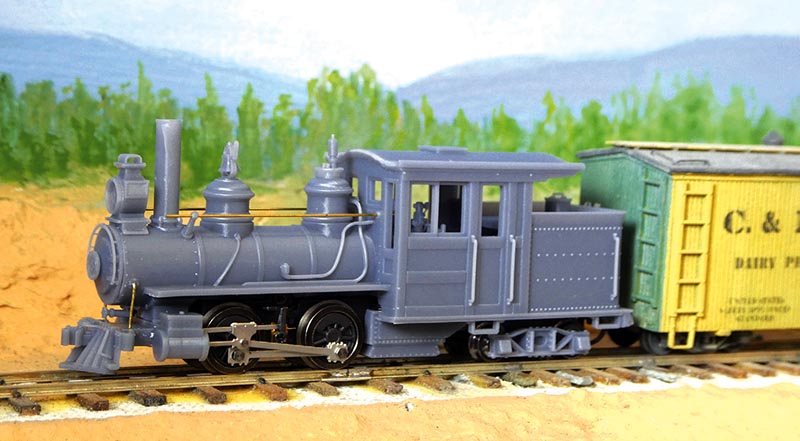Maine’s 2-foot-gauge Sandy River Railroad took delivery of an 18-ton 0-4-4T Forney from the Portland Company in May 1891. The engine became Sandy River No. 5, and when the rail-road was consolidated into the Sandy River & Rangeley Lakes in 1908, it was renumbered SR&RL No. 6.
That was just the first of many changes. In 1924, the locomotive moved to the Kennebec Central Railroad, where it served as No. 4. In 1931, it was sold to the Wiscasset, Waterville & Farmington to become road No. 9. And in 1937, it was sold yet again to William Monypeny and moved to a farm in northeastern Connecticut.
In 1995, the much-travelled locomotive moved back to Maine. The WW&F Museum at Alna negotiated a deal to take custody of No. 5/6/4/9 and restore her to operation. In 2015, 20 years and countless man-hours later, the re-built engine steamed again on the WW&F, shiny as a new penny.
Toma Model Works of Japan makes an HOn30 kit of No. 6, which consists of a pre-assembled mechanism and 3D printed plastic superstructure parts. The smooth-running mechanism features an 8mm x 16mm 12-volt coreless motor in the cab and tank, with spur gears and two worms turning the drivers. Pickup is via spring wires behind the drivers. The model is SR&RL No. 6 early version, with an oil headlight and no vacuum brake muffler. Toma has a late version in the works.
The 3D parts are superb, with freestanding hand rails and grabs rendered delicately in scale. The dark gray plastic is not styrene and must be bonded with ACC or epoxy. The kit includes 1.4mm screws to attach the pilot, cylinders and frame to the body, and the tank truck to the frame. A hex-head cap screw serves as a wrench for the driver crankpins. Toma provides 2 pieces of .4mm brass wire for boiler handrails, and a small sheet of dry transfers. There’s also a tiny disk of clear plastic for headlight glass and three number plates.
The instructions are on Toma’s web site. They are pictorial, with captions in Japanese and English. Assembly takes a couple of hours, and the fit of the parts is outstanding. The 3D parts are superb, with freestanding hand rails and grabs rendered delicately in scale. The dark gray plastic is not styrene and must be bonded with ACC or epoxy.

The kit includes 1.4mm screws to attach the pilot, cylinders and frame to the body, and the tank truck to the frame. A hex-head cap screw serves as a wrench for the driver crankpins. Toma provides 2 pieces of .4mm brass wire for boiler handrails, and a small sheet of dry transfers. There’s also a tiny disk of clear plastic for headlight glass and three number plates.
The instructions are on Toma’s web site. They are pictorial, with captions in Japanese and English. Assembly takes a couple of hours, and the fit of the parts is outstanding. weight over the drivers where it’s needed. I added enough lead to keep the engine down on the drivers and will add more when I rewire it for DCC operation.
The rear of the model will accommodate a Micro-Trains No. 2001 N coupler. The pilot has a molded dummy coupler.
The model is accurate, in fact, some of the details are almost too delicate. The only missing items are a rod from the cab to the sand dome to operate the sanders, and the tiny tubes that convey cylinder lubrication from the cab to the valves. I made the pilot deck braces—shown on photos of the model but not mentioned in the instructions—from the leftover boiler handrail wire.
I purchased my kit on the Toma web site and it arrived in the mail 12 days later. Total cost was $213.20, including a $6.21 charge for foreign currency conversion levied by my credit card company.
Toma Model Works
No Address Listed
No Phone Listed




